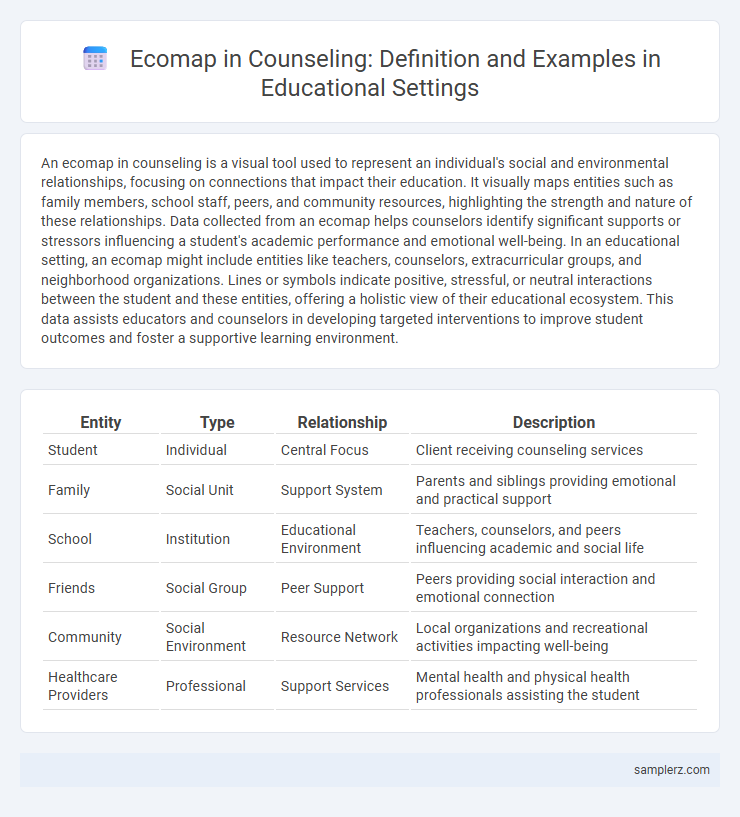An ecomap in counseling is a visual tool used to represent an individual's social and environmental relationships, focusing on connections that impact their education. It visually maps entities such as family members, school staff, peers, and community resources, highlighting the strength and nature of these relationships. Data collected from an ecomap helps counselors identify significant supports or stressors influencing a student's academic performance and emotional well-being. In an educational setting, an ecomap might include entities like teachers, counselors, extracurricular groups, and neighborhood organizations. Lines or symbols indicate positive, stressful, or neutral interactions between the student and these entities, offering a holistic view of their educational ecosystem. This data assists educators and counselors in developing targeted interventions to improve student outcomes and foster a supportive learning environment.
Table of Comparison
| Entity | Type | Relationship | Description |
|---|---|---|---|
| Student | Individual | Central Focus | Client receiving counseling services |
| Family | Social Unit | Support System | Parents and siblings providing emotional and practical support |
| School | Institution | Educational Environment | Teachers, counselors, and peers influencing academic and social life |
| Friends | Social Group | Peer Support | Peers providing social interaction and emotional connection |
| Community | Social Environment | Resource Network | Local organizations and recreational activities impacting well-being |
| Healthcare Providers | Professional | Support Services | Mental health and physical health professionals assisting the student |
Understanding Ecomaps: A Tool in Counseling Education
Ecomaps in counseling visually represent clients' social environments, highlighting relationships with family, friends, and community resources to identify stressors and support systems. They are integral in counseling education for teaching students to assess social dynamics and ecological influences on mental health. By mapping these connections, counselors can develop targeted interventions that enhance client well-being and resilience.
The Role of Ecomaps in School Counseling
Ecomaps play a crucial role in school counseling by visually representing students' social and environmental connections, aiding counselors in identifying support systems and potential stressors. These diagrams map relationships between students and key influences like family, peers, teachers, and community resources, enabling targeted interventions. Utilizing ecomaps fosters strengthened student engagement, improved emotional well-being, and enhanced academic success.
How Ecomaps Facilitate Student-Centered Assessments
Ecomaps in counseling visually represent students' social and environmental relationships, enabling counselors to identify influential factors impacting academic performance and emotional well-being. This tool highlights connections between family, peers, school, and community resources, promoting a comprehensive, student-centered assessment. By mapping these interactions, ecomaps guide tailored interventions that address specific needs and strengthen support networks.
Step-by-Step Guide to Creating Ecomaps in Educational Settings
Creating ecomaps in educational counseling involves first identifying the student at the center and mapping key relationships such as family members, teachers, peers, and community resources using circles connected by lines indicating the relationship's quality and intensity. Counselors then assess these connections to visualize support systems and potential stressors impacting the student's academic and social development. This step-by-step process enhances personalized intervention plans by providing a holistic understanding of the student's ecological context within the education environment.
Ecomap Example: Supporting At-Risk Students
An ecomap example supporting at-risk students illustrates their social connections, highlighting relationships with family, school personnel, and community resources to identify sources of stress and support. This visual tool maps positive and negative interactions, such as peer influence, academic challenges, and access to counseling services, to tailor intervention strategies. Utilizing ecomaps enhances counselors' ability to address barriers and foster resilience in vulnerable student populations.
Utilizing Ecomaps for Family Dynamics Analysis in Schools
Ecomaps serve as valuable tools in school counseling by visually representing students' family dynamics and social relationships, helping counselors identify support systems and stressors affecting academic performance and emotional well-being. Mapping connections between family members, peers, and community resources enables targeted interventions tailored to each student's unique context. Using ecomaps promotes a holistic understanding of students' environments, facilitating more effective communication and collaboration between counselors, families, and educators.
Case Study: Ecomap Application in Adolescent Counseling
In adolescent counseling, an ecomap visually illustrates the youth's relationships with family, peers, school, and community resources, highlighting sources of support and stress. A case study demonstrated how an ecomap identified a teenager's strained parental connections and robust peer support, guiding targeted interventions to strengthen family communication and leverage peer networks. This tool enhanced counselor understanding of environmental influences on adolescent behavior and informed personalized coping strategies.
Enhancing Teacher-Parent Communication Through Ecomaps
Ecomaps in counseling serve as powerful tools to visually represent the relationships and social networks impacting a student's learning environment, facilitating clearer communication between teachers and parents. By mapping out family dynamics, school resources, and community support, educators can gain deeper insights into a child's external influences and collaborate more effectively with parents to address academic and social challenges. This shared visual framework promotes transparency and fosters a united approach to supporting student success.
Integrating Ecomaps into Counseling Curricula
Integrating ecomaps into counseling curricula enhances students' ability to visualize clients' social environments by mapping relationships and external influences. These tools facilitate a holistic understanding of clients' support systems, stressors, and resources, enabling counselors to develop targeted intervention strategies. Practical exercises in creating and interpreting ecomaps prepare future counselors to apply systemic approaches in diverse clinical settings.
Digital Ecomap Tools for Modern Educational Counselors
Digital ecomap tools enhance educational counseling by visually mapping students' social and academic support systems using interactive software like Genogram Analytics or ecomap templates in platforms such as Lucidchart. These tools allow counselors to identify key relationships, stressors, and resources influencing student well-being and academic performance, facilitating targeted interventions and personalized support plans. Integration of digital ecomaps streamlines data collection and analysis, improving real-time decision-making and collaboration between counselors, educators, and families.

example of ecomap in counseling Infographic
 samplerz.com
samplerz.com